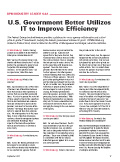How does one define the term “Business Architecture” (BA)? Before an enterprise undertakes a Business Architecture initiative, it must have a clear understanding of what it is and how it is defined. Perhaps by first parsing the term “Business Architecture,” and then characterizing it as a whole and complete term, one can bring clarity to its definition. And of course, the Business Architecture requires an association and some context with the enterprise as well. This article will offer one perspective on the definition of Business Architecture; hopefully, stimulating



















